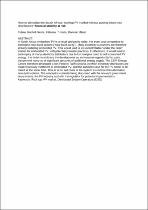 ResearchSpace
ResearchSpace
How to stimulate the South African rooftop PV market without putting electricity distributors' financial stability at risk
JavaScript is disabled for your browser. Some features of this site may not work without it.
- ResearchSpace
- →
- Research Publications/Outputs
- →
- Conference Publications
- →
- View Item
| dc.contributor.author |
Bischof-Niemz, Thomas

|
|
| dc.contributor.author |
Roro, Kittessa T

|
|
| dc.contributor.author |
Milazi, Dominic

|
|
| dc.date.accessioned | 2017-12-14T11:53:22Z | |
| dc.date.available | 2017-12-14T11:53:22Z | |
| dc.date.issued | 2015 | |
| dc.identifier.citation | Bischof-Neimz, T, Roro, KT, and Milazi, D. 2015. How to stimulate the South African rooftop PV market without putting electricity distributors' financial stability at risk.31st European PV Solar Energy Conference and Exhibition (EU PVSEC 2015), 14-18 September 2015, Hamburg, Germany, pp 3121-3126 | en_US |
| dc.identifier.isbn | 978-1-5108-2013-5 | |
| dc.identifier.uri | http://toc.proceedings.com/29703webtoc.pdf | |
| dc.identifier.uri | http://hdl.handle.net/10204/9862 | |
| dc.description | Copyright: 2015 WIP Wirtschaft und Infrastruktur GmbH & Co. Planungs-KG. Due to copyright restrictions, the attached PDF file only contains the abstract of the full text item. For access to the full text item, kindly consult the publisher's website. | en_US |
| dc.description.abstract | In South Africa, embedded PV is at retail grid parity today. It is even cost-competitive to alternative new-build options (“new-build parity”). Many electricity customers are therefore already installing embedded PV. This would lead to an uncontrollable “under the radar” market for embedded PV, with potentially unsafe practices. Furthermore, it would lead to bankruptcy of many electricity distributors due to lost margins owed to self-consumed PV energy. It is better to embrace the development as an immense opportunity for quick, inexpensive ramp-up of significant amounts of additional energy supply. The CSIR Energy Centre therefore developed a Net Feed-in Tariff concept, in which electricity distributors are made financially indifferent to embedded PV, and the business case for the PV owner is de-risked at the same time. This all at no net costs to the system as compared to alternative new-build options. The concept is currently being discussed with the relevant government departments, the PV industry and with the regulator for potential implementation. | en_US |
| dc.language.iso | en | en_US |
| dc.publisher | WIP Wirtschaft und Infrastruktur GmbH & Co. Planungs-KG | en_US |
| dc.relation.ispartofseries | Worklist;16594 | |
| dc.subject | Rooftop PV market | en_US |
| dc.subject | Distributed System Operators | en_US |
| dc.subject | DSO | en_US |
| dc.subject | South African electricity distributors | en_US |
| dc.title | How to stimulate the South African rooftop PV market without putting electricity distributors' financial stability at risk | en_US |
| dc.type | Conference Presentation | en_US |
| dc.identifier.apacitation | Bischof-Niemz, T., Roro, K. T., & Milazi, D. (2015). How to stimulate the South African rooftop PV market without putting electricity distributors' financial stability at risk. WIP Wirtschaft und Infrastruktur GmbH & Co. Planungs-KG. http://hdl.handle.net/10204/9862 | en_ZA |
| dc.identifier.chicagocitation | Bischof-Niemz, Thomas, Kittessa T Roro, and Dominic Milazi. "How to stimulate the South African rooftop PV market without putting electricity distributors' financial stability at risk." (2015): http://hdl.handle.net/10204/9862 | en_ZA |
| dc.identifier.vancouvercitation | Bischof-Niemz T, Roro KT, Milazi D, How to stimulate the South African rooftop PV market without putting electricity distributors' financial stability at risk; WIP Wirtschaft und Infrastruktur GmbH & Co. Planungs-KG; 2015. http://hdl.handle.net/10204/9862 . | en_ZA |
| dc.identifier.ris | TY - Conference Presentation AU - Bischof-Niemz, Thomas AU - Roro, Kittessa T AU - Milazi, Dominic AB - In South Africa, embedded PV is at retail grid parity today. It is even cost-competitive to alternative new-build options (“new-build parity”). Many electricity customers are therefore already installing embedded PV. This would lead to an uncontrollable “under the radar” market for embedded PV, with potentially unsafe practices. Furthermore, it would lead to bankruptcy of many electricity distributors due to lost margins owed to self-consumed PV energy. It is better to embrace the development as an immense opportunity for quick, inexpensive ramp-up of significant amounts of additional energy supply. The CSIR Energy Centre therefore developed a Net Feed-in Tariff concept, in which electricity distributors are made financially indifferent to embedded PV, and the business case for the PV owner is de-risked at the same time. This all at no net costs to the system as compared to alternative new-build options. The concept is currently being discussed with the relevant government departments, the PV industry and with the regulator for potential implementation. DA - 2015 DB - ResearchSpace DP - CSIR KW - Rooftop PV market KW - Distributed System Operators KW - DSO KW - South African electricity distributors LK - https://researchspace.csir.co.za PY - 2015 SM - 978-1-5108-2013-5 T1 - How to stimulate the South African rooftop PV market without putting electricity distributors' financial stability at risk TI - How to stimulate the South African rooftop PV market without putting electricity distributors' financial stability at risk UR - http://hdl.handle.net/10204/9862 ER - | en_ZA |





